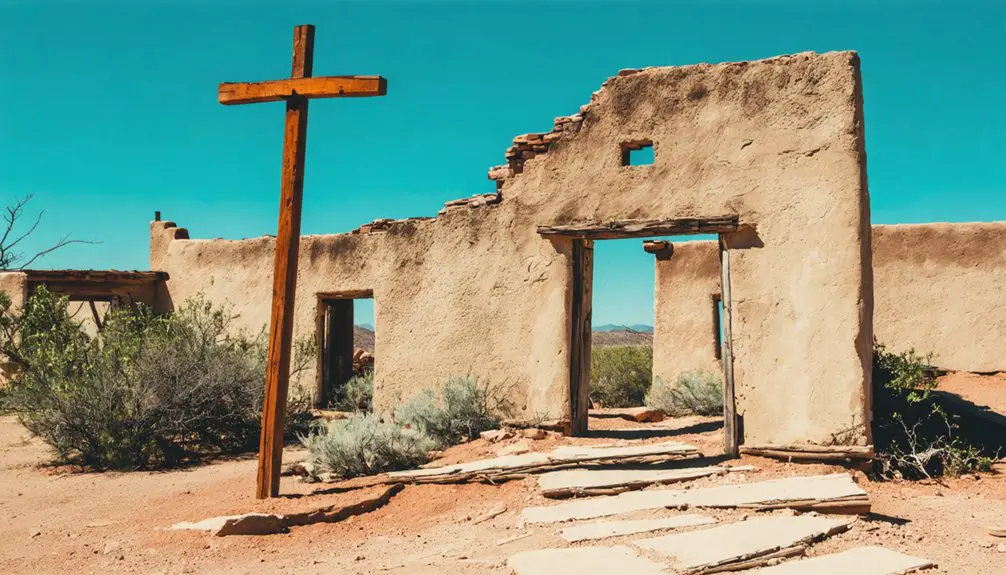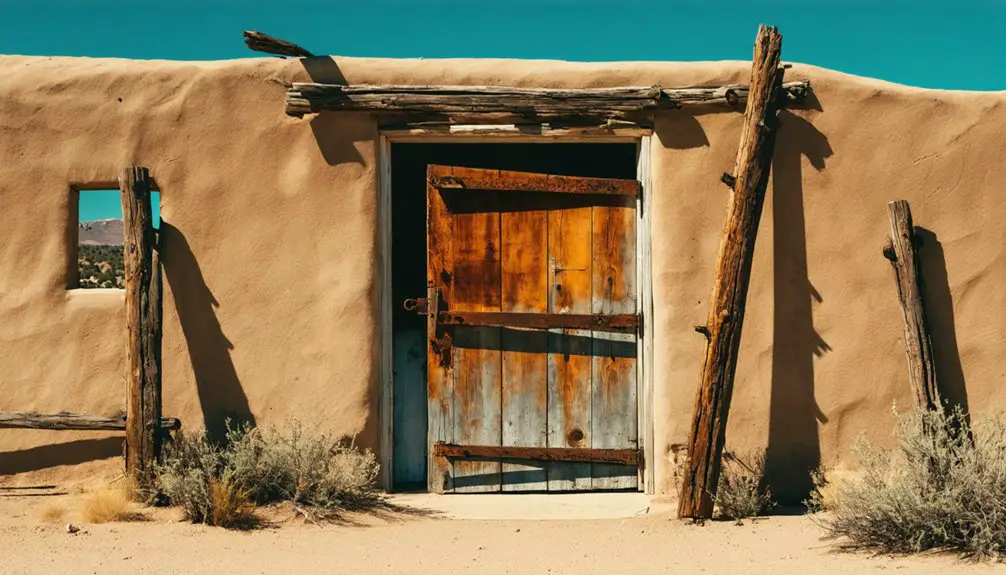You’ll find Trementina, New Mexico, established in 1870 by Presbyterian families fleeing religious persecution, nestled in the harsh desert landscape. This once-thriving ranching community built sturdy flagstone homes and churches, with sheep herding as its economic backbone. Environmental challenges, including severe droughts and uranium contamination in the 1950s, coupled with declining water resources, forced families to abandon their properties. The ghost town’s ruins and cemeteries now tell a compelling story of faith, resilience, and adaptation in early rural New Mexico.
Key Takeaways
- Trementina, established in 1870 by Presbyterian families, transformed from a thriving ranching community into a ghost town due to environmental challenges.
- Water contamination from uranium mining and severe droughts in the 1950s forced many families to abandon their Trementina properties.
- The town’s original flagstone buildings and church ruins remain as testament to early 20th-century rural New Mexican life.
- Post-World War II economic changes and transportation shifts isolated Trementina, prompting younger residents to migrate to urban areas.
- Historic cemeteries and church records preserve the legacy of Trementina’s generational homesteaders and their religious heritage.
The Rise of a Presbyterian Outpost
Around 1870, Presbyterian families seeking refuge from religious persecution established the settlement of Trementina in New Mexico, having previously fled from Los Valles de San Agustin and La Aguila.
Settler motivations centered on finding a place where they could freely practice their faith, distinguishing themselves from the region’s mainly Catholic settlements.
These early settlers, primarily sheep ranchers who’d grazed their flocks in nearby areas, quickly built the foundations of their new community. The residents constructed their homes using local flagstone for durability.
Years later, the site would become notable when the Church of Spiritual Technology purchased land there in 1986.
You’ll find their priorities reflected in the immediate construction of both a Presbyterian church and schools, creating a self-sustaining religious outpost.
The community dynamics revolved around their shared faith, with the church serving as both a spiritual beacon and social hub.
This religious foundation helped Trementina’s residents maintain their distinct cultural identity in New Mexico’s diverse landscape.
Life in Early Trementina
If you’d settled in Trementina in the late 1870s, you’d have joined a tight-knit Presbyterian community fleeing religious persecution from nearby settlements like Los Valles de San Agustin.
You’d have found your neighbors, including ordained leaders Pablo Madrid, Noberto Jaramillo, Abran Salzar, and Romulo Blea, working to establish both religious freedom and a functioning ranching society.
Your daily life would’ve centered around seasonal sheep grazing migrations, managing scarce water resources, and participating in a community where Presbyterian values shaped social structures and daily interactions. Like the indigenous peoples before them, the settlers developed complex irrigation systems to sustain their agricultural needs. The village’s first homestead began around 1875, marking the start of permanent settlement in the area.
Religious Roots and Settlement
During the early 1870s, Presbyterian sheep ranchers migrated from nearby settlements like Los Valles de San Agustin, Chaperito, and La Liendre to establish Trementina along fertile grazing lands.
These settlers, seeking religious freedom from persecution in their previous communities, forged strong community bonds as they claimed homesteads starting around 1875.
The settlement’s Presbyterian foundation deepened in 1887 when four pivotal members – Pablo Madrid, Noberto Jaramillo, Abran Salzar, and Romulo Blea – were ordained as spiritual leaders.
Their influence shaped settler experiences through mission work and religious education.
When Alice Blake opened Trementina’s first school in 1901, it reinforced the community’s dedication to both faith and learning. As a dedicated mission teacher of the Southwest, Blake helped establish educational standards that would influence the region for years to come.
The Protestant movement gained further momentum through younger leaders like Cecilio Valverde, while the church and cemetery became lasting symbols of their religious heritage.
Daily Ranch Life
Life in early Trementina centered on sheep ranching, where families managed extensive flocks across grazing lands that stretched toward Los Valles de San Agustin, Chaperito, and La Liendre.
You’d find ranching traditions deeply rooted in Hispanic and Pueblo practices, with livestock management skills passed down through generations of mestizo and genizaro workers.
Your home would’ve been built from local flagstone, expertly laid by skilled craftsmen like the Jaramillo family, who could complete a house in just three days.
You’d have lived close to your corrals and outbuildings, with wooden vigas and latillas from nearby mesas forming your roof.
Daily life meant working together with extended family, sharing the demanding tasks of shepherding and maintaining the ranch while facing environmental challenges like drought. The 1250 acres of land provided ample space for grazing and sustaining multiple family homesteads.
The area later became known for its secretive Scientology base, where religious archives and artifacts are now stored in underground facilities.
Environmental Challenges and Economic Struggles
You’ll find that by the 1950s, Trementina’s agricultural prospects dimmed as prolonged droughts depleted local water tables and devastated crop yields.
The environmental degradation worsened when uranium mining contaminated groundwater supplies, making it increasingly difficult for ranchers to maintain their livestock operations. Tests revealed groundwater contained radium 226 levels up to 31 times higher than natural levels, severely impacting water quality.
These combined pressures forced many farming and ranching families to abandon their properties, accelerating the area’s economic decline and eventual transformation into a ghost town, following the same boom-and-bust cycle that affected many New Mexico settlements.
Water Scarcity Impact Agriculture
Water scarcity has profoundly reshaped agriculture in Trementina and its surrounding New Mexico regions, where industrial farming operations consume over 80% of the state’s freshwater resources.
You’ll find the impacts most visible in the declining Ogallala Aquifer, where water allocation struggles have pushed many farms to the brink of collapse.
The region’s agricultural sustainability faces mounting challenges as mega-dairies guzzle 32 million gallons daily while alfalfa and pecan operations drain critical water supplies.
You’re witnessing a transformation as farmers abandon traditional crops like winter wheat and cotton for drought-resistant alternatives. Recent shifts show producers transitioning to sorghum cultivation as a water-conserving solution.
The economic ripples are severe – farmworkers face uncertain employment, while operational costs soar as farmers drill deeper for diminishing groundwater.
These pressures continue to reshape the landscape, threatening both private wells and community water sources.
Drought Devastated Local Economy
As prolonged drought conditions intensified across Trementina, the local economy suffered devastating ripple effects that extended far beyond agriculture.
You’d have seen rising water costs hitting businesses hard, from farms to small manufacturing operations, creating a domino effect throughout the community’s economic framework.
The town’s drought economics revealed a harsh reality – as surface water became scarce, locals were forced to rely on costly groundwater pumping.
This financial strain wasn’t limited to farmers; it impacted retail shops, construction projects, and food processing facilities.
You’ll find that Trementina’s experience mirrors other New Mexican communities where local resilience was tested by persistent water shortages.
The economic toll particularly affected the region’s tribal populations, who relied heavily on cattle production and agriculture for their livelihood.
Environmental Threats To Ranching
Environmental threats in Trementina’s ranching community intensified through a complex web of challenges, from severe land degradation to mounting wildfire risks.
You’ll find that overgrazing historically damaged the rangeland’s capacity to sustain livestock, while invasive species further diminished pasture quality. The situation’s gotten worse as drought conditions limit vegetation recovery.
Water contamination from industrial activities, including fracking, has threatened both surface and groundwater supplies you’d need for your cattle.
Meanwhile, ineffective wildfire management and limited funding for fuel reduction projects have left your ranching infrastructure vulnerable to destruction.
You’re also facing stricter regulations and mounting costs to maintain operations, while misconceptions about ranching’s environmental impact create additional hurdles for your long-term planning and investment decisions.
Religious Heritage and Cultural Identity

The religious heritage of Trementina took shape through the pioneering efforts of Reverend Jose Emiterio Cruz, who built the town’s first church with just $300 in funding. As the community grew, you’d find increasing religious diversity, from Presbyterian converts Santiago and Juana Blea to their Baptist minister son Romulo.
Cultural preservation remained strong through the establishment of the Church of God in Christ Mennonite congregation in 1944.
- The original church doubled as a schoolhouse until fire destroyed it in 1916
- Local curanderas provided essential medical care and traditional healing
- The 1948 Mennonite migration to Tucumcari marked a significant cultural shift
- The Blea family’s conversion influenced the town’s religious identity
The rebuilt church, dedicated to Santiago and Juana Blea, stood as a symbol of the community’s resilient spirit and evolving faith traditions.
The Path to Becoming a Ghost Town
While religious institutions remained pillars of community life, Trementina’s path toward abandonment began with transformative economic shifts in post-World War II New Mexico.
You’ll find the town’s decline closely linked to major transportation shifts, as diesel locomotives replaced steam engines and bypassed smaller stops. The construction of modern highways further isolated the community, reducing traveler traffic that once sustained local businesses.
Demographic changes accelerated the town’s transformation into a ghost town. Young residents moved to urban areas seeking better opportunities, while older community members couldn’t maintain the town’s economic significance.
The harsh desert environment and limited water resources complicated efforts to sustain agriculture, while the broader region’s changing economy left Trementina struggling to adapt to new realities.
Legacy and Historical Significance
Nestled along Trementina Creek in San Miguel County, this historic settlement first took root around 1870 when Presbyterian families fleeing religious persecution established a close-knit ranching community.
Their legacy of community resilience lives on through historical documentation, preserved in church records and genealogical data that tell the story of this remarkable place.
Through faded pages and family trees, we trace the enduring strength of a community that refused to be forgotten.
- The Francis Ray Mission and Miss Alice Blake’s work in establishing schools and churches shaped the town’s social foundation.
- Multiple cemeteries, including Presbyterian and Catholic burial grounds, mark the final resting places of generational homesteaders.
- The post office’s establishment in 1901 connected Trementina to wider regional networks.
- Material culture remains visible today through building ruins and artifacts, offering tangible links to early 20th-century rural New Mexican life.
Frequently Asked Questions
Are There Any Remaining Buildings That Visitors Can Safely Explore Today?
While you might be drawn to these intriguing historic structures, there aren’t any buildings safe for interior exploration. You’ll need to admire the adobe ruins and windmills from a distance for visitor safety.
What Haunted Stories or Legends Are Associated With Trementina’s Abandoned Sites?
You’ll hear tales of haunted encounters near the Presbyterian church ruins, where ghostly apparitions are said to emerge at dusk—spirits of settlers, epidemic victims, and those who fled during hard times.
How Can Descendants Trace Their Family History Connected to Trementina?
Like piecing together an old quilt, you’ll need to combine genealogical research from church records, census data, and historical archives while gathering oral histories from elder relatives and local descendants.
What Are the Current Property Ownership Laws Regarding the Ghost Town?
You’ll need to verify property rights through county records and follow state abandonment laws before pursuing land acquisition. Private ownership remains protected even in ghost towns despite apparent abandonment.
Is Special Permission Required to Visit or Photograph the Ghost Town?
With 90% of ghost towns on private land, you’ll need explicit permission for regulated areas and photography. Check local ghost town regulations, respect no-trespassing signs, and obtain clearance from property owners.
References
- https://trementina1871.wordpress.com/history-to-trementina/
- https://newmexicotravelguy.com/new-mexico-ghost-towns/
- https://trementina1871.wordpress.com
- https://www.ghosttowns.com/states/nm/trementina.html
- http://wikimapia.org/38504645/Trementina-Ghost-Town-Ruins
- https://en.wikipedia.org/wiki/Trementina_Base
- https://upload.wikimedia.org/wikipedia/commons/f/f5/The_land_of_sunshine;_a_handbook_of_the_resources
- https://trementina1871.wordpress.com/1st-families-of-trementina/
- https://core.ac.uk/download/pdf/217606515.pdf
- https://digitalrepository.unm.edu/cgi/viewcontent.cgi?article=2841&context=nmhr



